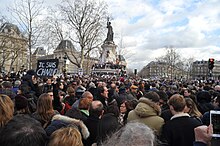Place de la République
 Monument à la République at the centre of the square, topped by a statue of Marianne | |
| Length | 283 m (928 ft) |
|---|---|
| Width | 119 m (390 ft) |
| Arrondissement | 3rd, 10th, 11th |
| Quarter | Arts-et-Métiers Enfants-Rouges Porte-Saint-Martin Folie-Méricourt |
| Coordinates | 48°52′02.20″N 2°21′50.60″E / 48.8672778°N 2.3640556°E |
| From | Boulevard du Temple |
| To | Boulevard Saint-Martin |
| Construction | |
| Denomination | 7 May 1879 |
The Place de la République (known as the Place du Château d'Eau until 1879) is a square in Paris, located on the border between the 3rd, 10th and 11th arrondissements. The square has an area of 3.4 ha (8.4 acres).[1][2] Named after the First, Second and Third Republics, it contains a monument, the Monument à la République, which includes a statue of the personification of France, Marianne.
The
History
Construction
The square was originally called the Place du Château d'Eau, named after a huge fountain designed by Pierre-Simon Girard and built on the site in 1811.[3] Émile de La Bédollière wrote that the water came from la Villette and that the fountain was "superb" in character. In 1867, Gabriel Davioud built a more impressive fountain in the square, which (like the first fountain) was decorated with lions.[3] The square took its current shape as part of Baron Hausmann's vast renovation of Paris.[4] Haussmann also built new barracks on the cities, to garrison troops useful in times of civil unrest.[5]
Renovation
Paris mayor
Demonstrations

After terrorist attacks against France in January 2015, crowds gathered in the square to mourn and express solidarity against the threat of Islamic extremism.[8] The French Interior Ministry estimated that as many as 1.6 million people participated, making it the largest demonstration in modern French history.[8] Crowds again rallied on the Place de la République following the November 2015 Paris attacks.[9]
In 2016, the
Monument à la République

At the center of the Place de la République is a 31 feet (9.4 m) bronze statue of
The monument was created by the brothers Charles and
Metro stations
The Place de la République is:
| Located near the République .
|
It is served by lines 3, 5, 8, 9, and 11.
Streets meeting at the Place de la République
- Boulevard de Magenta
- Rue Beaurepaire
- Rue Léon-Jouhaux
- Rue du Faubourg du Temple
- Avenue de la République
- Boulevard Voltaire
- Boulevard du Temple
- Passage du Vendôme
- Rue du Temple
- Boulevard Saint-Martin
- Rue René Boulanger
References
- ^ a b Warner, p. 250
- ^ "Quelle place de la république pour demain ?". mairie10.paris.fr. Archived from the original on 1 February 2014. Retrieved 20 July 2014.
- ^ a b c Hazan, p. 84.
- ^ Borrus, p. 111.
- ^ Borrus, p. 111; Kirkland, p. 112.
- ^ a b c d e f Kim Willsher, Paris mayor praises beauty of revamped Place de la République: Bertrand Delanoë says £20.4m renovation of French capital's historic square has allowed it to be reclaimed by the people, Guardian (June 16, 2013).
- ^ a b c d Réaménagement de la place de la République: Paris (France), 2013, Centre de Cultura Contemporània de Barcelona.
- ^ a b Liz Alderman & Dan Bilefsky, Huge Show of Solidarity in Paris Against Terrorism, New York Times (January 11, 2015).
- ^ Caroline Chauvet & Rick Rojas, At Place de la République, a Defiant Gathering to Mourn, New York Times (November 14, 2015).
- ^ Nossiter, Adam. "A New Generation’s Anger Resounds From a Packed Plaza in Paris." The New York Times, 29 April 2016.
- ^ Archived at Ghostarchive and the Wayback Machine: "Act XXIII: Yellow Vests demonstrate in Paris". YouTube.
- ^ "Paris Police, Yellow Vests Clash as Anti-Macron Protests Hold Up". Bloomberg. 20 April 2019. Retrieved 2022-05-02.
- ^ "The Latest: French protesters demand attention from Macron". 21 April 2019.
- ^ Michalski, p. 18.
- ^ a b Michalski, p. 17.
- ^ a b c Michalski, pp. 17-18.
- ^ Michalski, pp. 18-19.
- ^ Michalski, pp. 16-17.
- ^ Quand Paris dansait avec Marianne, 1879-1889, exhibition catalog, Musée du Petit Palais, Paris, 1989.
Sources
- Kathy Borrus, Five Hundred Buildings of Paris (Black Dog & Leventhal: 2003).
- Eric Hazan, The Invention of Paris: A History in Footsteps (Verso: 2010; trans. David Fernbach).
- Stephane Kirkland, Paris Reborn: Napoléon III, Baron Haussmann, and the Quest to Build a Modern City (Macmillan: 2013).
- Sergiusz Michalski, Public Monuments: Art in Political Bondage 1870-1997 (Reaktion: 1998).
- Marina Warner, Monuments & Maidens: The Allegory of the Female Form (University of California: 1985).
External links
 Media related to Place de la République (Paris) at Wikimedia Commons
Media related to Place de la République (Paris) at Wikimedia Commons

